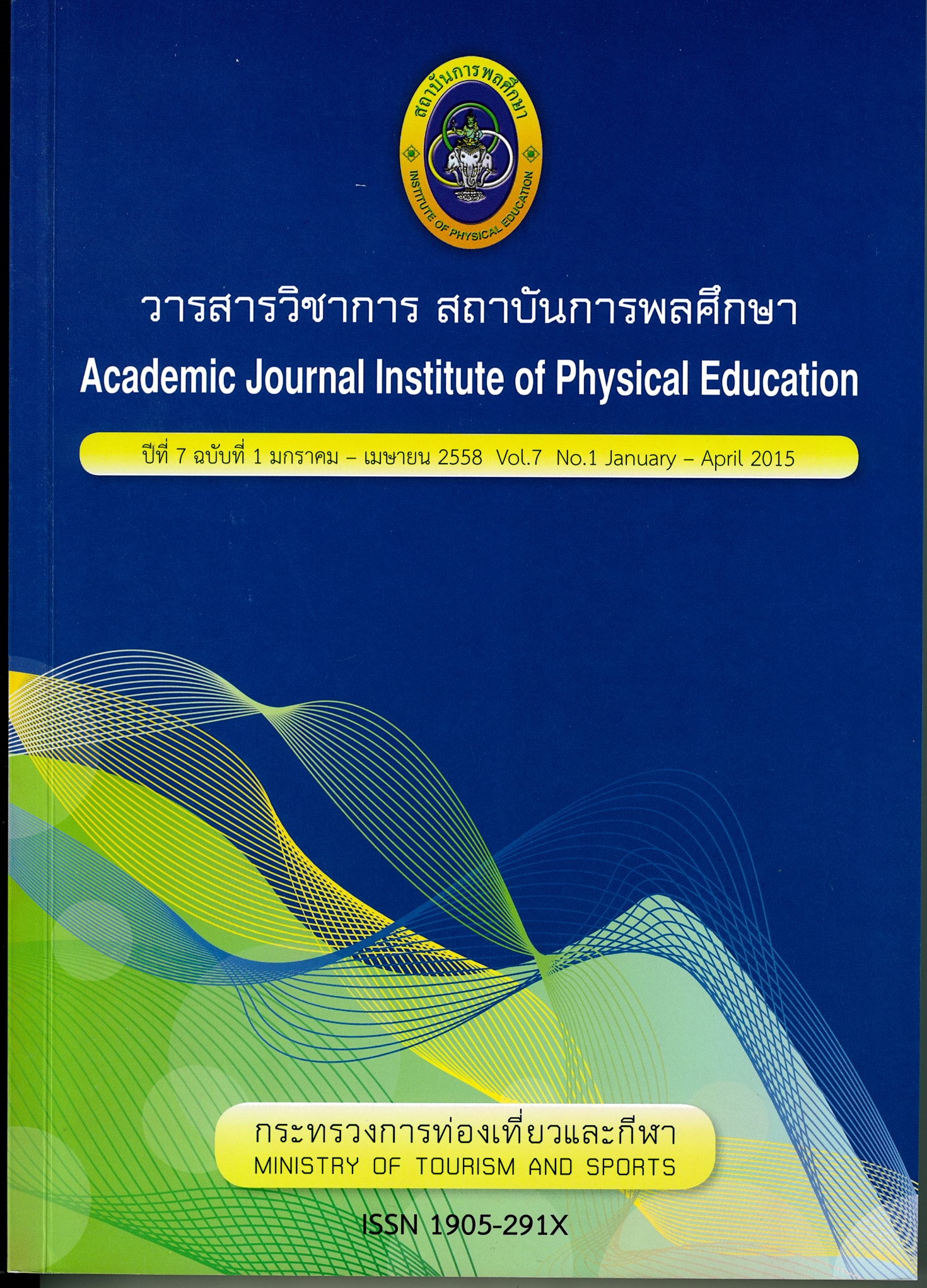Administration for Developing Excellent Artistic Gymnastics as Perceived by Stakeholders
Main Article Content
Abstract
The purpose of this study was to explore an administrative pattern for successful development of artistic gymnastics from steak holders' perspective. Participants were 10 coaches, 10 athletes and 10 administrators who involved with artistic gymnastics sport. Data were collected through semi-structured interview, stimulated recall with photograph and concept mapping and were analyzed using a constant comparison. Trustworthiness was established using triangulation and prolonged engagement. Results indicated that in order to develop artistic gymnastics, three groups of steak holders namely coaches, athletes and administrators needed to be developed. Developing coaches included determining level of coaches, increasing numbers of coaches, improving capability of coaches and enhancing coaching experiences. Developing athletes involved increasing numbers of athletes, enhancing athletes' ability and promoting their competitive experiences. Lastly, developing administrators included setting appropriate terms for being administrative committees of gymnastic association, seeking budget for purchasing equipment and providing fund for improving quality of coaches and athletes.
Article Details

This work is licensed under a Creative Commons Attribution-NonCommercial-NoDerivatives 4.0 International License.
The published article is a copyright of the Academic Journal of Thailand National Sports University. The passage appeared in each article in this academic journal is a perspective of each author which is not related to the journal. Each author is required to be responsible for all components of his/her own article. If there are any mistakes, each author must be responsible for those mistakes on his/her own.
References
การกีฬาแห่งประเทศไทย. (2541). แผนพัฒนาการกีฬาแห่งชาติ ฉบับที่ 2. กรุงเทพ: นิวไทยมิตรการพิมพ์ (1996) จํากัด.
จารุพงศ์ พลเดช. (2546). การบริหารแบบมีส่วนร่วมและการให้อํานาจปฏิบัติ, วารสารพัฒนาชุมชน. 42(4): 13.
เดโช แสนภักดี. (2546). ปัจจัยที่ส่งผลต่อการมีส่วนร่วมในโครงการหนึ่งตําบลหนึ่งผลิตภัณฑ์ของ สมาชิกกลุ่มอาชีพจังหวัดขอนแก่น, ปริญญานิพนธ์, กรุงเทพฯ: บัณฑิตวิทยาลัยมหาวิทยาลัยเกษตรศาสตร์. ถ่ายเอกสาร.
บรรณสิทธิ สิทธิบรรณกูล. (2548). การศึกษาสภาพการดําเนินการจัดการทางการกีฬาขององค์การบริหารส่วนตําบล จังหวัดนครนายก. ปริญญานิพนธ์ กศ.ม. (สาขาวิชาพลศึกษา), กรุงเทพฯ: บัณฑิตวิทยาลัย มหาวิทยาลัยศรีนครินทรวิโรฒ. ถ่ายเอกสาร.
เปี่ยมศักดิ์ ภูมิพานิชย์. (2547), สภาพและปัญหาของผู้ฝึกสอนโครงการเงินอุดหนุนการเตรียมความพร้อมสู่ความเป็นเลิศในการแข่งขันกีฬาของการกีฬาแห่งประเทศไทย ปีงบประมาณ 2546. ปริญญานิพนธ์ กศ.ม. (สาขาวิชาพลศึกษา), กรุงเทพฯ: บัณฑิตวิทยาลัย มหาวิทยาลัยศรีนครินทรวิโรฒ. ถ่ายเอกสาร.
นเรศ กุลธวงศ์วัฒนา. (2537), คุณลักษณะที่เป็นจริงและคุณลักษณะที่พึงประสงค์ของผู้ฝึกสอนกีฬายิมนาสติกตามการรับรู้ของนักกีฬา ผู้ฝึกสอน และผู้จัดการทีม. ปริญญานิพนธ์ กศ.ม. (สาขาวิชาพลศึกษา), กรุงเทพฯ: บัณฑิตวิทยาลัย มหาวิทยาลัยศรีนครินทรวิโรฒ. ถ่ายเอกสาร.
สมาคมยิมนาสติกแห่งประเทศไทย. (2554). แผนยุทธศาสตร์กีฬายิมนาสติก, กรุงเทพฯ: ถ่ายเอกสาร.
สาลี่ สุภาภรณ์. (2550). วิจัยเชิงคุณภาพทางพลศึกษาและกีฬา, กรุงเทพฯ: ห้างหุ้นส่วนจํากัดสามลดา.
สมยศ นาวีการ. (2545). การบริหารแบบมีส่วนร่วม. กรุงเทพฯ: ม.ป.พ.
Federation International Gymnastics. (2013). Code of Point. Retrieved September 3, 2013, from www.Olympic.org/fig-artistic gymnastics.
Freeman, R.E. (1984). Strategic Management: Stakeholders Approach. Boston: Pitman.
Nguyen, Mina Thanh Van Dinh. (2000). Coaching Gymnastics Successfully: A Strategies Manual for Coaches, Gymnasts, and Parent. ProQuest Dissertations & Theses (PQDT) pg. n/a


